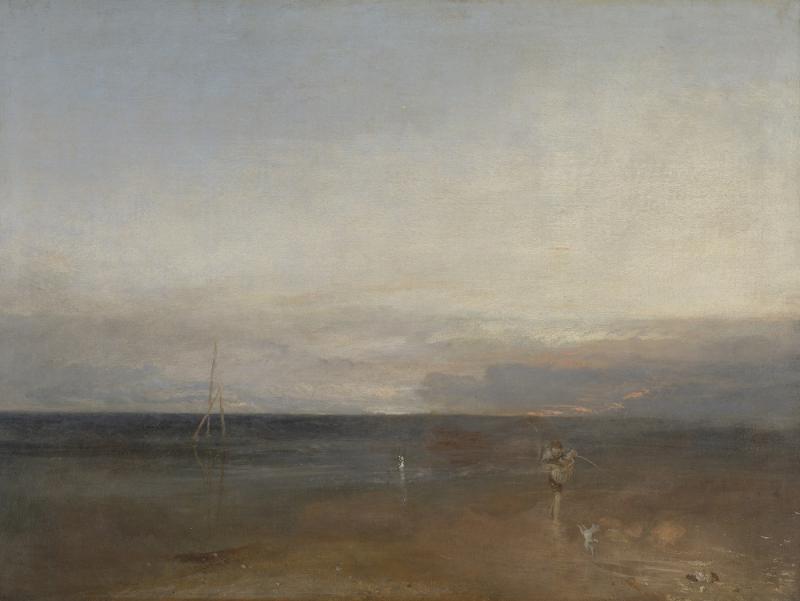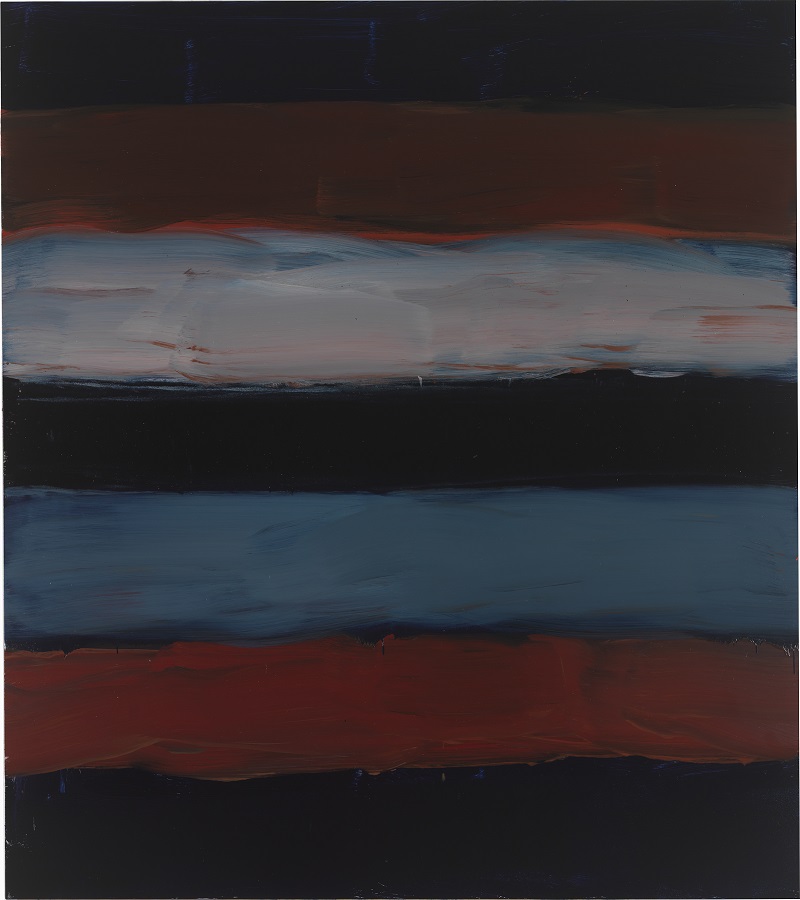Sea Star: Sean Scully, National Gallery review - analysing past masters | reviews, news & interviews
Sea Star: Sean Scully, National Gallery review - analysing past masters
Sea Star: Sean Scully, National Gallery review - analysing past masters
The latest encounter between a living artist and the national collection

This exhibition of new work by Sean Scully is the latest in a series of encounters between contemporary artists and works in the National Gallery. Irish-born Scully pays homage to paintings he has known since his childhood, spent in London. Scully emphasises that the Landline series, represented here by three paintings and a number of works on paper, is not simply a response to Turner’s The Evening Star, that in its depiction of light, and water and wet sand underfoot, is a remarkably complete evocation of sensory experience. Nevertheless, his works appear here as both interrogations and meditations on Turner’s painting, which, in an echo of Scully’s own approach lies somewhere between abstraction and figuration.
 Landline Pool, with its palette of blue and black, focuses on the expressive capabilities of the brush, a large house-painting brush on aluminium amplifying the gloss and texture of the painted surface. Each sweep of paint holds within it the energy of the brushstroke that put it there, just as in The Evening Star, visible brushstrokes remind us that what we see has not been conjured up, but put there by hand and eye. In Landline Star (Pictured right), the effects of colour laid one over the other take centre stage: Scully analyses Turner’s painting element by element, in a perpetual process of looking, painting and looking again.
Landline Pool, with its palette of blue and black, focuses on the expressive capabilities of the brush, a large house-painting brush on aluminium amplifying the gloss and texture of the painted surface. Each sweep of paint holds within it the energy of the brushstroke that put it there, just as in The Evening Star, visible brushstrokes remind us that what we see has not been conjured up, but put there by hand and eye. In Landline Star (Pictured right), the effects of colour laid one over the other take centre stage: Scully analyses Turner’s painting element by element, in a perpetual process of looking, painting and looking again.
The act of looking, rather than painting itself is underlined by Scully’s response to Van Gogh’s Chair, 1888, a painting that Scully first saw aged 17, and that provides the second major reference point in this show. He was struck by its workmanlike depiction of the textures and colours of tiles, wood, and woven fibres, qualities that, he says: “made it possible for me to think that I could actually make paintings.”
There is much to learn here of Scully’s own practice and his relationship to his forbears. Perhaps his paintings help us to see Turner and Van Gogh afresh. But if their strength is as commentaries on other people’s work, it is the fatal weakness that prevents them from being works of consequence in themselves.
- Sea Star: Sean Scully at the National Gallery until 11 August 2019
- More visual arts reviews on theartsdesk
rating
Explore topics
Share this article
The future of Arts Journalism
You can stop theartsdesk.com closing!
We urgently need financing to survive. Our fundraising drive has thus far raised £49,000 but we need to reach £100,000 or we will be forced to close. Please contribute here: https://gofund.me/c3f6033d
And if you can forward this information to anyone who might assist, we’d be grateful.

Subscribe to theartsdesk.com
Thank you for continuing to read our work on theartsdesk.com. For unlimited access to every article in its entirety, including our archive of more than 15,000 pieces, we're asking for £5 per month or £40 per year. We feel it's a very good deal, and hope you do too.
To take a subscription now simply click here.
And if you're looking for that extra gift for a friend or family member, why not treat them to a theartsdesk.com gift subscription?
more Visual arts
 'We are bowled over!' Thank you for your messages of love and support
Much-appreciated words of commendation from readers and the cultural community
'We are bowled over!' Thank you for your messages of love and support
Much-appreciated words of commendation from readers and the cultural community
![SEX MONEY RACE RELIGION [2016] by Gilbert and George. Installation shot of Gilbert & George 21ST CENTURY PICTURES Hayward Gallery](https://theartsdesk.com/sites/default/files/styles/thumbnail/public/mastimages/Gilbert%20%26%20George_%2021ST%20CENTURY%20PICTURES.%20SEX%20MONEY%20RACE%20RELIGION%20%5B2016%5D.%20Photo_%20Mark%20Blower.%20Courtesy%20of%20the%20Gilbert%20%26%20George%20and%20the%20Hayward%20Gallery._0.jpg?itok=7tVsLyR-) Gilbert & George, 21st Century Pictures, Hayward Gallery review - brash, bright and not so beautiful
The couple's coloured photomontages shout louder than ever, causing sensory overload
Gilbert & George, 21st Century Pictures, Hayward Gallery review - brash, bright and not so beautiful
The couple's coloured photomontages shout louder than ever, causing sensory overload
 Lee Miller, Tate Britain review - an extraordinary career that remains an enigma
Fashion photographer, artist or war reporter; will the real Lee Miller please step forward?
Lee Miller, Tate Britain review - an extraordinary career that remains an enigma
Fashion photographer, artist or war reporter; will the real Lee Miller please step forward?
 Kerry James Marshall: The Histories, Royal Academy review - a triumphant celebration of blackness
Room after room of glorious paintings
Kerry James Marshall: The Histories, Royal Academy review - a triumphant celebration of blackness
Room after room of glorious paintings
 Folkestone Triennial 2025 - landscape, seascape, art lovers' escape
Locally rooted festival brings home many but not all global concerns
Folkestone Triennial 2025 - landscape, seascape, art lovers' escape
Locally rooted festival brings home many but not all global concerns
 Sir Brian Clarke (1953-2025) - a personal tribute
Remembering an artist with a gift for the transcendent
Sir Brian Clarke (1953-2025) - a personal tribute
Remembering an artist with a gift for the transcendent
 Emily Kam Kngwarray, Tate Modern review - glimpses of another world
Pictures that are an affirmation of belonging
Emily Kam Kngwarray, Tate Modern review - glimpses of another world
Pictures that are an affirmation of belonging
 Kiefer / Van Gogh, Royal Academy review - a pairing of opposites
Small scale intensity meets large scale melodrama
Kiefer / Van Gogh, Royal Academy review - a pairing of opposites
Small scale intensity meets large scale melodrama
 Jenny Saville: The Anatomy of Painting, National Portrait Gallery review - a protégé losing her way
A brilliant painter in search of a worthwhile subject
Jenny Saville: The Anatomy of Painting, National Portrait Gallery review - a protégé losing her way
A brilliant painter in search of a worthwhile subject
 Abstract Erotic, Courtauld Gallery review - sculpture that is sensuous, funny and subversive
Testing the boundaries of good taste, and winning
Abstract Erotic, Courtauld Gallery review - sculpture that is sensuous, funny and subversive
Testing the boundaries of good taste, and winning
 Edward Burra, Tate Britain review - watercolour made mainstream
Social satire with a nasty bite
Edward Burra, Tate Britain review - watercolour made mainstream
Social satire with a nasty bite
 Ithell Colquhoun, Tate Britain review - revelations of a weird and wonderful world
Emanations from the unconscious
Ithell Colquhoun, Tate Britain review - revelations of a weird and wonderful world
Emanations from the unconscious

Add comment